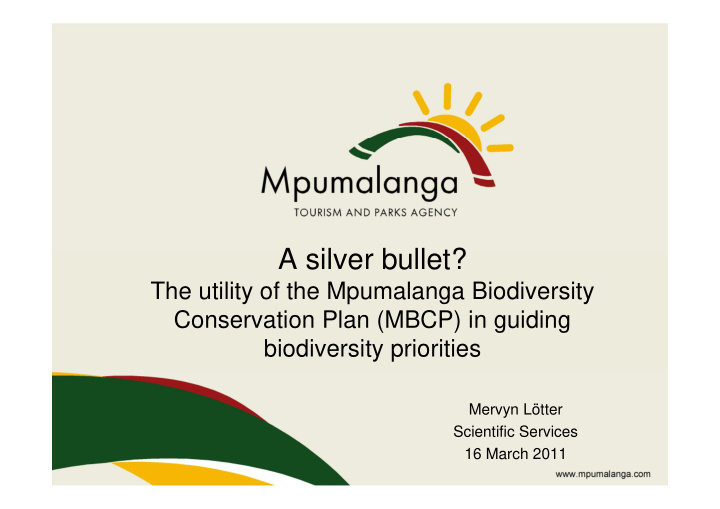



A silver bullet? The utility of the Mpumalanga Biodiversity Conservation Plan (MBCP) in guiding biodiversity priorities Mervyn Lötter Scientific Services 16 March 2011
Overview of presentation • Need for a conservation assessment • Systematic Conservation Planning • Integrated assessment (aquatic & terrestrial) • Defining biodiversity status • Formalisation of land-use guidelines • Political support • Way forward
Why the need for a conservation plan ? Land-use change (2005-2010)
Minerals responsible for land-use change coal 0% 0% 0% 0% 0% 0% 0% 0% 0% 0% 0% 0% 0% 0% 1% 0% 0% 1% 1% 1% gold 1%1% gravel, sand & clay 3% PGM all minerals 5% iron Chrome, cobolt, PGM, Vanadium, base metals, PGM, gold cobalt, copper 5% petroleum nickel & iron silica vanadium diamonds granite tin & copper clay closure chrome lithium andalusite base metals 78% verdite copper kaolin quarts
Prior to MBCP …….. • Reviewing of applications were re-active and handled on a case-by-case basis. • Comments were often subjective and not objective. • Strong need to pro-actively plan so that decisions are part of a strategic plan with conservation of biodiversity as its foundation.
MBCP Objective To develop a spatial conservation planning tool that will: 1) identify a representative and viable sample of biodiversity; 2) ensure environmental sustainable development; and 3) support the strategic objectives of MTPA (i.e. Mpumalanga Protected Expansion Strategy)
Systematic Conservation Planning 1. Compile and collate data on the biodiversity of the planning region 2. Set quantitative targets for biodiversity features 3. Review targets against existing conservation areas 4. Analyse and identify additional areas requiring conservation (spatial biodiversity priority areas) 5. Implement conservation actions on the ground (e.g. sustainable development, PA Expansion) 6. Maintain the required values of biodiversity areas & update plan
SCP Principles In short, if we want to conserve biodiversity effectively, we need to conserve: � a representative sample of all biodiversity (pattern) � ensure ecological and evolutionary processes that allow this biodiversity to persist over time (process) � set targets for the conservation of biodiversity features
Assessment Overview Aquatic Biodiversity Assessment (identifying important subcatchments) Assessment of competing land-uses to minimize conflict Incorporate into final Terrestrial Biodiversity Assessment
Terrestrial Assessment 65 000 Hexagons (118 ha each) as planning units • 340 biodiversity features • 68 Vegetation units • Amphibians (3 taxa) • Birds (17 taxa) • Invertebrates (17 taxa) • Mammals (13 taxa) • Plants (190 taxa) • Reptiles (10 species) • Ecological processes • Revised protected area • Transformation (lost habitat) • Competing land uses/threats • Priority subcatchments •
Targets for vegetation types (graph courtesy SANBI) 100% of species • NSBA 2004 75% • species area curve target 100% of area eg 35%
Biodiversity is target driven Explicit quantitative targets reflecting what you want to conserve to achieve a living landscape Examples of Targets Used Targets Vegetation Lyndenburg Montane Grassland 24% Ourebia ouribi Mammal 7500 ha Metisella meninx Butterfly 1 locality Bird Blue Swallow (nesting) 2 km buffer around nest sites Bufo gariepensis nubicolus Frog 400 ha Cordylus giganteus Reptile 1000 ha Plant Cycads (critically engangered) All known localities Warburgi a (muthi) Plant 15 localities (21 total)
Prioritised spatial threats
Threat layer
Conservation planning software MARXAN identify smallest possible area to meet all the targets. Limit on total size of conservation system (efficiency & minimizing costs) CLUZ user-friendly GIS interface • Complimentarity – incorporating species not represented elsewhere • Efficiency – protecting the most species per unit area
Biodiversity data Protected areas Transformation Targets LU Pressures Aquatic Assessment ������ ����� Portfolio highlights most Software and GIS Randomly runs 100 times to select efficient selection of areas most efficient area to meet targets - required to meet biodiversity Irreplaceability targets
Need to convert ‘irreplaceability’ map into meaningful output • Categorizes output according to land-use options (or flexibility) • Irreplaceable = 100% irreplaceable sites • Highly Significant = 50 - 99% irreplaceable sites • Important & Necessary = Ideal reserve network to meet targets • Least concern = Not required to meet target • No natural habitat remaining = Transformed
SANBI: Findings on the relative impact of land-uses on biodiversity
Proposed Land-use Guidelines
ArcExplorer 2 CD-Rom version
Aquatic Assessment – underpinning Terrestrial Assessment Planning units are subcatchments: • modelled from 90M DEM 1503 units • Average size: 5820 ha • List of Aquatic Biodiversity Features Rivers • Wetlands • Species (4 threatened fish) • Peat wetlands • Hydrological important areas/high water yield • Processes (pan and wetland clusters) • • Supporting layers (e.g. PESC & transformation) • 157 Features used in final assessment
Political support Presented to MEC DALA at onset of project (June 2005) • Presented outcome to MEC DALA (December 2005) • Presented to Mpumalanga Cabinet (January 2006) • Presented to MEC DEDP (February 2006) • Presented to all municipalities (July & August 2006) • DALA presented to Economic Cluster (February 2008) • Presented to municipalities & teachers at Enviro Expo (June • 2008) Presented to Social Cluster (July 2008) • Endorsed by Mpumalanga CABINET (August 2008) •
MBCP uses Guide the identification of Threatened Ecosystems (Biodiversity Act) • Spatial priorities for Mpumalanga Protected Area Expansion Strategy • Form basis of Bioregional Plan for Gert Sibande District (Biodiversity • Act) Geographic priority areas in terms of EIA regs (Listing Notice 3) • Currently consulted to assess all development applications in • Mpumalanga (internal) Informs priority areas for Working for Water activities • Informs municipal IDPs and SDFs (work in progress) •
Segmented satellite PUs Way forward Strong reliance on SCP to fast-track development • … but MBCP useful in that it can only assist in • conserving what we know Gaps in data may result in biodiversity loss • Currently revising MBCP Climate change plant refugia • Improvements include: • Updated landcover (& old lands) • Additional species information • Segmented planning units • NFEPA aquatic assessment • Improved land-use guidelines • Climate change resilient & corridor areas •
THANK YOU
Recommend
More recommend